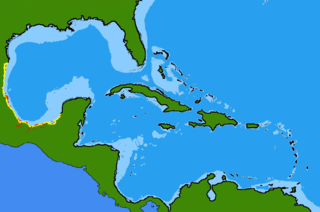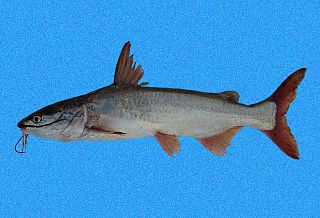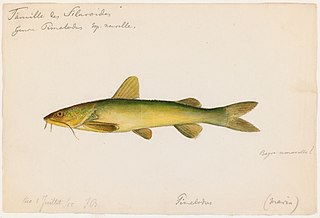
The Ariidae or ariid catfish are a family of catfish that mainly live in marine waters with many freshwater and brackish water species. They are found worldwide in tropical to warm temperate zones. The family includes about 143 species.

Cathorops is a genus of catfishes in the family Ariidae found in the Atlantic and Pacific Oceans. These species are found in the eastern and western Central and South America in brackish and freshwater habitats. This genus is a strongly supported clade of this family. It consists of a natural group in which the monophyly is well-defined by morphological and molecular evidence and the genus probably includes several unrecognized species from both American coasts.
The New Granada sea catfish, or Cazon sea catfish is a species of catfish in the family Ariidae. It is endemic to the Atrato and Magdalena River basins in Colombia.
The Mapalé is an Afro-Colombian and Ecuadorian style of dance that was brought over by the slaves and representing the fishermen after a long day of work. Its name comes from the Cathorops mapale (fish) when they are out of the water. The dance moves are compared with the agility and strength of those who are performing it. From the clothing to the precise moves of the hips and shoulders. The body movements during the dance are swiftly made to follow the beating of the drums and represent the fish out of the water (men), while the women are the sea.

The coco sea catfish is a species of sea catfish in the family Ariidae. It was described by Carl Linnaeus in 1776, originally under the genus Silurus. It inhabits tropical marine and brackish waters ranging between Colombia and the Amazon River, in South America. It dwells at a maximum depth of 50 m (160 ft). It reaches a maximum total length of 55 cm (22 in), more commonly reaching 40 cm (16 in).
The red sea catfish, also called the long-barbeled sea catfish, is a species of sea catfish in the family Ariidae. It was described by Franz Steindachner in 1876, originally under the genus Aelurichthys. It inhabits tropical marine, brackish and freshwater in the eastern-central and southeastern Pacific regions, including Mexico, Colombia, Ecuador, Costa Rica, Guatemala, Honduras, El Salvador, Panama, Nicaragua, and Peru. It dwells at a maximum depth of 20 m (66 ft). It reaches a maximum total length of 95 cm (37 in), but more commonly reaches 30 cm (12 in).
Cathorops agassizii is a species of sea catfish in the family Ariidae. It was described by Carl H. and Rosa Smith Eigenmann in 1888, originally under the genus Tachisurus. It is a tropical freshwater fish which is known from Guyana and Brazil. It reaches a maximum length of 32 cm (13 in).

The estuarine sea catfish, also known as the Aguadulce sea catfish, is a species of sea catfish in the family Ariidae. It was described by Seth Eugene Meek in 1904, originally under the genus Galeichthys. It is a tropical fish which is known from Mexico to Guatemala, where it typically inhabits freshwater rivers, lagoons, and drainages, also sometimes dwelling in marine waters. It reaches a maximum standard length of 22.7 cm (8.9 in).

Cathorops wayuu, the Wayuu sea catfish, is a species of sea catfish. It is found in shallow coastal and estuarine waters from Camarones in Colombia to the Gulf of Paria in Venezuela. Maximum recorded body length is 31.4 cm.
Cathorops festae is a species of sea catfish in the family Ariidae. It was described by George Albert Boulenger in 1898. It is known from Peru and Ecuador.
The papillate sea catfish, also known as the Kailola's sea catfish, is a species of sea catfish in the family Ariidae. It was described by Alexandre Pires Marceniuk and Ricardo Betancur-Rodríguez in 2008. It is a tropical fresh and saltwater catfish which occurs in Central America. It reaches a standard length of 25.4 cm (10.0 in).
The Conguito sea catfish is a species of catfish in the family Ariidae. It was described by Susan Brown Bristol in 1897. It is a tropical, freshwater catfish which occurs in Mexico. It reaches a standard length of 19.7 cm (7.8 in).
Cathorops manglarensis is a species of catfish in the family Ariidae. It was described by Alexandre Pires Marceniuk in 2007. It is a tropical, fresh and saltwater catfish which occurs in Colombia. It reaches a standard length of 19.5 cm (7.7 in).
The Dark sea catfish is a species of catfish in the family Ariidae. It was described by Albert Günther in 1864. It is a tropical, freshwater catfish which occurs in Guatemala. It reaches a total length of 23 cm (9.1 in).

The Box sea catfish is a species of catfish in the family Ariidae. It was described by Albert Günther in 1864. It is a tropical, marine catfish which occurs in Guatemala, Costa Rica, El Salvador, Colombia, Peru, Ecuador, Mexico, Nicaragua, Honduras, and Panama. It dwells at a maximum depth of 20 m (66 ft). It reaches a 30 cm (12 in).
The Orinoco sea catfish is a species of catfish in the family Ariidae. It was described by Albert Günther in 1864. It is a tropical, fresh and saltwater catfish which occurs between Venezuela and Guyana. It reaches a standard length of 24.5 cm (9.6 in).
The Curator sea catfish, also known as the Raredon's sea catfish, is a species of catfish in the family Ariidae. It was described by Alexandre Pires Marceniuk, Ricardo Betancur-Rodríguez and Arturo Acero Pizarro in 2009. It is a tropical, marine and freshwater-dwelling fish which occurs between Mexico and El Salvador.

The Madamango sea catfish, also known as the Raspfin sea catfish or the Spring cuirass, is a species of catfish in the family Ariidae. It was described by Louis Agassiz in 1829. It is a tropical, marine and brackish water-dwelling catfish which occurs between Colombia and Brazil. It inhabits a depth range between 1 and 50 m. It reaches a maximum total length of 30 cm (12 in), more commonly reaching a TL of 20 cm (7.9 in).

The Steindachner's sea catfish is a species of catfish in the family Ariidae. It was described by Charles Henry Gilbert and Edwin Chapin Starks in 1904. It is a tropical, marine and freshwater-dwelling catfish which occurs between Costa Rica and Peru. It dwells at a maximum depth of 20 m (66 ft). It reaches a maximum total length of 36 cm (14 in), more commonly reaching a TL of 20 cm (7.9 in).
The crucifix sea catfish — also known as the Christfish, the crucifix/crucifex catfish, the crucifixfish, or the gillbacker, — is a species of catfish in the family Ariidae.








